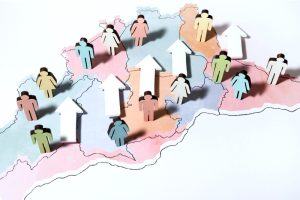How Many Babies Are Born In The World Every Second?
Have you ever wondered how many babies are born in the world every second? Or how the birth rate differ across different countries and cultures? What impact does this global baby boom have on society, the economy, and the environment? How does the pace of population growth affect our ability to sustainably support future generations?
These are just a few of the fascinating questions that arise when we consider the incredible pace at which new life enters the world. Join us as we explore this phenomenon and its profound implications for the future of our planet.
Diving into the realm of birth rates and fertility statistics opens a window to understanding the dynamics that drive population expansion. From the crucial factors influencing family planning decisions to the implications of demographic shifts on resources and the environment, the global birth rate narrative is both fascinating and complex.
In this blog, “How Many Babies Are Born In The World Every Second?” we venture on a journey to unravel the mysteries behind the statistics, exploring the sustainability of population growth amidst the evolving social and environmental landscapes. Join us as we delve into the numbers, trends, and implications that underpin the global baby boom phenomenon.
How Many Babies Are Born In The World Every Second?

Understanding global population dynamics is essential for comprehending the challenges and opportunities that arise from population growth. At the heart of this growth is the remarkable phenomenon of how many babies are born every second around the world. The continuous arrival of newborns shapes the future of societies, economies, and the environment.
The number of births per second is a key indicator of population dynamics. It reflects the balance between fertility rates, mortality rates, and migration patterns in different regions. The concept of births per second helps us grasp the speed at which the global population is expanding.
While the precise number fluctuates, estimates suggest that approximately 4.3 births occur worldwide every second. This means that over 330,000 babies are born each day, translating to over 120 million newborns per year.
The significance of understanding births per second lies in its implications for demographics, resource allocation, and the environment. By exploring the factors that influence population growth and evaluating its sustainability, we can better comprehend the challenges and opportunities that emerge from a rapidly changing world.
Let’s dive deeper into the various aspects of global birth rates and unravel the statistics and insights behind the number of babies born every second!
Global Birth Rates and Demographic Insights

Understanding global birth rates is key to comprehending the dynamics of population growth and its impact on society. Let’s delve into the current birth rates around the world and examine regions with the highest and lowest rates of population growth.
Birth Rates by Region
- Sub-Saharan Africa
This region has the highest birth rates globally, with countries like Niger, Angola, and Mali experiencing an average of over 6 births per woman. Factors such as limited access to contraceptives, high child mortality rates, and cultural norms contribute to these high birth rates.
- Middle East and North Africa
Countries like Yemen, Iraq, and Jordan also have high birth rates, influenced by similar factors in sub-Saharan Africa.
- Asia
Some countries in South Asia, including Afghanistan, Pakistan, and Bangladesh, have relatively high birth rates due to cultural and social norms, limited access to family planning resources, and a lack of education about reproductive health.
- Europe
On the other end of the spectrum, several European countries, like Germany, Spain, and Italy, are experiencing declining birth rates. This trend is attributed to factors such as increased access to contraception, delayed marriages, and a focus on career and personal aspirations.
Factors Influencing Birth Rates
- Socioeconomic factors
Education and income levels have a significant impact on birth rates. Countries with higher education levels and economic development tend to have lower birth rates as individuals prioritize career growth and quality of life.
- Family planning and access to contraceptives
The availability and affordability of contraceptives play a crucial role in enabling individuals to plan their families and determine the timing of pregnancies.
- Cultural and societal norms
Cultural beliefs surrounding gender roles, religious practices, and preferences for large families also influence birth rates.
Understanding the global birth rates and the disparities across different regions provides valuable insights into the demographic trends and the challenges and opportunities that arise from population growth.
By examining the factors that drive these birth rates, policymakers and organizations can develop effective strategies for sustainable population growth and address the specific needs of diverse populations.
Factors Influencing Fertility and Birth Rates

Fertility rates and the number of babies born per second globally are influenced by a multitude of factors. Understanding these factors can shed light on the patterns of population growth and the dynamics of birth rates. Here are some key factors that contribute to fertility rates:
Socioeconomic Factors
Socioeconomic factors play a significant role in determining fertility rates. Income levels, education, and access to healthcare have a direct impact on family planning decisions. In regions with lower socioeconomic status, where access to education and healthcare is limited, fertility rates tend to be higher. Conversely, in areas with higher levels of education and economic stability, fertility rates are often lower.
Cultural and Religious Beliefs
Cultural and religious beliefs also influence fertility rates. In some cultures, having a large number of children is seen as a desirable and fulfilling aspect of life. These cultural and religious beliefs can lead to higher fertility rates in certain communities.
Availability and Use of Contraception
The availability and use of contraception methods play a vital role in determining fertility rates. Access to contraception allows individuals to plan and space their pregnancies effectively. Regions with better access to contraception often experience lower fertility rates.
Government Policies and Family Planning Programs
Government policies and family planning programs can have a significant impact on fertility rates. Initiatives that promote family planning, education, and healthcare services can effectively lower birth rates. Countries with comprehensive family planning programs often witness a decline in fertility rates.
Social Norms and Gender Roles
Social norms and gender roles can shape fertility rates as well. In societies where the traditional role of women is primarily associated with child-rearing, fertility rates tend to be higher. As gender norms shift and women gain more opportunities for education and careers, fertility rates often decline.
Health and Medical Advancements
Improvements in healthcare and medical advancements can influence fertility rates. Access to proper healthcare, prenatal care, and infant survival rates can impact the decision of individuals to have children. Regions with better healthcare services often experience lower fertility rates.
Understanding the various factors that influence fertility rates enables us to grasp the complexities of global population growth. By addressing these factors, policymakers and societies can work towards sustainable population growth, taking into account demographic, environmental, and social considerations.
Sustainable Population Growth: How Many Babies Are Born In The World Every Second?

Sustainable population growth is a critical aspect of global development that necessitates careful management and consideration of available resources and environmental factors. As the world’s population continues to grow at an unprecedented rate, it is imperative to address the long-term sustainability of this growth.
Balancing Resources and Demands
Achieving sustainable population growth requires a delicate balance between the available resources and the demands placed on them. This includes factors such as food production, freshwater availability, energy sources, and waste management. With an ever-increasing global population, it becomes crucial to ensure that these resources can meet the growing demands without depleting or damaging the environment.
Environmental Considerations
Environmental considerations play a vital role in sustainable population growth. The impact of increasing human activities on ecosystems, biodiversity, and climate change cannot be ignored. Striking a harmonious relationship between population growth and environmental conservation is fundamental for a sustainable future.
It calls for responsible resource consumption, promotion of renewable energy, conservation efforts, and measures to mitigate climate change.
Long-Term Planning and Policies
To achieve sustainable population growth, long-term planning and effective policies are essential. Governments and organizations need to invest in family planning programs, educate communities about the importance of sustainable population growth, and support initiatives aimed at empowering women.
Additionally, promoting education, ensuring access to healthcare, and empowering individuals to make informed decisions about their reproductive health can contribute to achieving sustainable population growth.
Sustainable population growth is a global challenge that requires collective effort and conscious decision-making. By striking a balance between resource availability, environmental considerations, and long-term planning, we can pave the way for a sustainable future for generations to come.
It is imperative that we address this issue with urgency to ensure a harmonious coexistence between human progress and the planet we call home.
Population growth has wide-ranging implications for society, the economy, and the environment. As the world’s population continues to expand, it is crucial to understand the effects and challenges posed by this growth. Let’s delve into the various impacts of population growth:
1. Strain on Resources and Environment
As the population increases, there is a greater demand for resources such as food, water, and energy. This puts strain on our planet’s finite resources, leading to issues such as deforestation, water scarcity, and pollution. The Sustainable Development Goals set by the United Nations highlight the importance of sustainable resource management to mitigate these challenges.
2. Pressure on Infrastructure and Services
Rapid population growth can place significant pressure on infrastructure and public services. Overcrowding in cities can lead to inadequate housing, increased traffic congestion, and overwhelmed healthcare and education systems. Planning and investment in infrastructure become vital to accommodate the growing population and maintain a high quality of life.
3. Socioeconomic Implications
Population growth can have both positive and negative socioeconomic implications. On one hand, a growing labor force can drive economic development and innovation. On the other hand, it can also lead to unemployment, income inequality, and social unrest if job opportunities are insufficient. Balancing economic growth with social equity becomes crucial to ensure sustainable development.
4. Environmental Footprint
The environmental footprint of a growing population becomes a significant concern. Increased consumption patterns and waste production contribute to climate change and environmental degradation. Adopting sustainable practices, promoting renewable energy sources, and reducing carbon emissions are imperative for mitigating the negative impacts on the environment.
5. Healthcare and Social Services
Population growth places increased demands on healthcare and social services. Providing adequate access to healthcare, education, and social support becomes a challenge as population sizes expand. Governments and organizations need to invest in these sectors to ensure the well-being and development of communities.
In summary, population growth has profound implications for society, the economy, and the environment. It is essential to address the challenges posed by this growth through sustainable resource management, infrastructure development, and social investments. By understanding these impacts, we can work towards creating a more sustainable and equitable future for all.
The Demographic Dividend: How Many Babies Are Born In The World Every Second?

The demographic dividend is a phenomenon that occurs when a country experiences a significant increase in its working-age population as a result of declining fertility rates. This demographic shift can have profound effects on economic growth and development.
During the demographic dividend phase, the proportion of working-age individuals increases relative to dependent populations such as children and the elderly. This surplus of working-age individuals creates an opportunity for economic growth as it can lead to increased productivity, innovation, and consumer spending.
One of the key factors contributing to the demographic dividend is the decline in the number of children being born. As fertility rates decrease, countries experience a shift in their demographics, with a larger proportion of the population entering the working-age group.
The demographic dividend provides several benefits for a country’s economy. With a larger working-age population, there is a greater potential for increased productivity and a more robust labor market. This can attract foreign investment and stimulate economic growth.
Moreover, the demographic dividend can also lead to increased savings and investment. As the working-age population grows, individuals have more opportunities to save and invest for their future, which can further drive economic development.
It’s important to note that the demographic dividend is not automatic. For a country to fully benefit from this phenomenon, it must have the necessary policies and infrastructure in place to support and capitalize on the growing working-age population. This includes investments in education, healthcare, and job creation.
However, the demographic dividend is not without its challenges. If a country fails to adequately invest in its human capital or address issues such as gender inequality and unemployment, the potential benefits of the demographic dividend may not be fully realized.
In conclusion, the demographic dividend represents a period of opportunity for countries experiencing a shift in their population demographics. With the right policies and investments, the demographic dividend can lead to sustained economic growth and development. However, careful planning and foresight are required to ensure that the benefits are maximized and shared equitably among all segments of society.
Declining Western Populations

The declining birth rates in Western countries have raised concerns about the potential implications for future generations. This demographic trend has significant implications for various aspects of society, including the economy, labor force, and social welfare systems.
Changing Family Dynamics
One of the primary factors contributing to declining birth rates in Western countries is the changing dynamics of family structures. With increasing gender equality, women now have more choices regarding education, career, and family planning. Many are delaying childbirth to pursue their personal and professional goals.
Additionally, societal norms have shifted, and couples are increasingly opting for smaller families or choosing not to have children at all.
Economic and Social Impacts
The declining birth rates in Western countries have substantial economic implications. A shrinking workforce can lead to labor shortages and impact economic growth. Moreover, social welfare systems heavily rely on a growing population to sustain them.
With fewer young people entering the workforce and more elderly individuals relying on pensions and healthcare services, governments may face budget constraints and strain on resources.
Future Challenges
The declining birth rates in Western countries raise concerns about the sustainability of populations in the long run. A low birth rate combined with increased life expectancy can lead to an aging population, placing a burden on healthcare systems and pension schemes. Additionally, a shrinking population can also result in a decrease in innovation, entrepreneurship, and cultural diversity.
Importance of Addressing the Issue
It is crucial for policymakers to address the issue of declining birth rates in Western countries. Encouraging family-friendly policies, such as parental leave and affordable childcare, can help alleviate the financial and societal pressures associated with raising children. Promoting work-life balance and supporting women’s career progression can also contribute to higher birth rates without compromising gender equality.
The declining birth rates in Western countries pose challenges for future generations and warrant attention from policymakers. Understanding the reasons behind this trend and implementing policies that support family-building can help ensure sustainable population growth, a balanced labor force, and a prosperous future for Western societies.
Sources:
Population Reference Bureau. “Why Are Birth Rates Declining in Developed Countries?” https://www.prb.org/why-are-birth-rates-declining-in-developed-countries/
Pew Research Center. “Low Fertility Rates Have Wide-ranging Consequences for U.S.” https://www.pewresearch.org/fact-tank/2021/05/25/low-fertility-rates-have-wide-ranging-consequences-for-u-s/
What Lies Ahead: Future Projections

As our world continues to evolve, it is crucial to gain insights into future projections of global population growth and the potential challenges that lie ahead. Here, we delve into the data and predictions that help us understand the trajectory of our global population and its implications.
1. Projected Population Growth
According to the United Nations, the global population is expected to reach 9.7 billion by 2050, and possibly surpass 11 billion by the end of the century. These projections take into account factors such as birth rates, mortality rates, and migration patterns. It is important to note that these are estimates and can be influenced by various socio-economic and environmental factors.
2. Regional Variations
Population growth is not evenly distributed across regions. While some parts of the world, such as sub-Saharan Africa, are projected to experience a rapid rise in population, other regions, like parts of Western Europe and Northern America, may face declining populations due to low birth rates and aging populations.
3. Potential Challenges
The increase in population can pose various challenges, including strain on resources such as food, water, and energy. Rapid urbanization, overcrowding in cities, and increased demand for healthcare and education are also potential issues that need to be addressed.
4. Environmental Impact
With a growing population, there is a greater demand for resources and an increased environmental footprint. Sustainable practices and policies will be crucial in ensuring the preservation of our planet for future generations.
5. Considerations for Planning
Understanding future population projections allows governments, organizations, and individuals to plan effectively. It helps inform decisions related to infrastructure development, healthcare systems, education, and environmental conservation efforts.
In conclusion, future projections of global population growth provide valuable insights into the challenges and opportunities that lie ahead. By considering these projections, we can work towards sustainable population growth and a better future for all.
Further Reading
For readers interested in delving deeper into the topic of global birth rates and population growth, here is a curated selection of resources and articles that provide valuable insights and analysis:
- “World Population Prospects 2019” This publication by the United Nations offers comprehensive data and projections on global population trends, including birth rates and fertility patterns.
- “The Demographic Transition Theory” Explore the concept of demographic transition and its impact on population growth and development with this informative article by the World Bank.
- “Population Matters” Visit the Population Matters website for a range of articles, reports, and resources examining the environmental and societal implications of population growth, as well as solutions for a sustainable future.
- “The Decline of Birth Rates in Developed Countries” Learn about the factors contributing to declining birth rates in developed nations, and the potential consequences, in this thought-provoking piece by the Brookings Institution.
- “The Population Reference Bureau” The Population Reference Bureau is a reputable organization that provides a wealth of information and analysis on population trends, reproductive health, and family planning.
By exploring these resources, you can gain a deeper understanding of the complex dynamics of global demographics and the factors shaping our world’s population. Happy reading!
FAQs: How Many Babies Are Born In The World Every Second?
To sum up, understanding global birth rates and population growth is crucial for creating a sustainable future. By exploring the resources and info mentioned above, we can gain valuable insights into the complex dynamics of demographics and the factors shaping our world’s population.
We hope we answered the question of how many babies are born in the world every second along the way with its impact. With this knowledge, we can work towards developing effective policies and solutions that address the challenges posed by population growth while ensuring the preservation of our planet’s resources for future generations.









Unlock the potential of your online business with trendilyna.com’s professional web development.